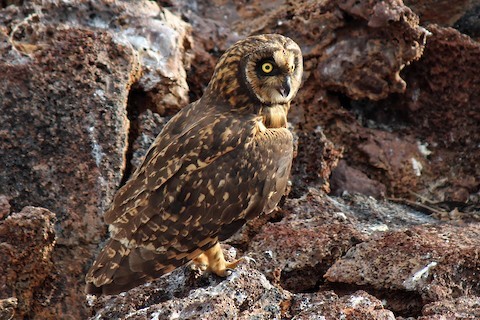Birdfinding.info ⇒ Globally endangered and uncommon, but often conspicuous and readily detected in its limited range. Most reliably seen around the seabird breeding colony at Prince Philip’s Steps on Isla Genovesa. Also often seen in the hills above Puerto Ayora on Isla Santa Cruz. Less consistent at most of the other frequently visited sites in the Galápagos.
Galápagos Short-eared Owl
Asio galapagoensis
Endemic to the Galápagos Archipelago, where it is resident on all the main islands. Occurs in all habitats in the islands, including wooded areas, barren lava fields, and seabird colonies.
Identification
Unique within its limited range. Very similar to the closely related, cosmopolitan Short-eared Owl (with which it is traditionally regarded as conspecific), but darker overall. Largely diurnal, but also active at night, and most active around dusk.

Great Gray Owl, S. n. nebulosa, dorsal view with head rotated to look backward. (Big Bar Lake Provincial Park, British Columbia; June 2022.) © Braden Judson
The plumage is mainly dark-brown and buffy overall, with strong black shadows around the eyes. The upperparts are mostly dark-brown with buffy spots.
The underparts are mostly buffy or whitish with dark-brown streaking throughout—dense and thick on the chest, becoming sparser on the belly. The belly streaks usually have cross-barring, which is rarely seen on other short-eared owls.
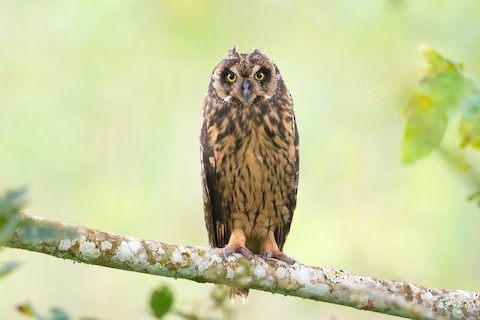
Galápagos Short-eared Owl, showing belly streaks with cross-barring. (Bellavista, Isla Santa Cruz, Galápagos, Ecuador; August 17, 2021.) © Adam Jackson
Immatures resemble adults, but typically have more extensive black on the face.
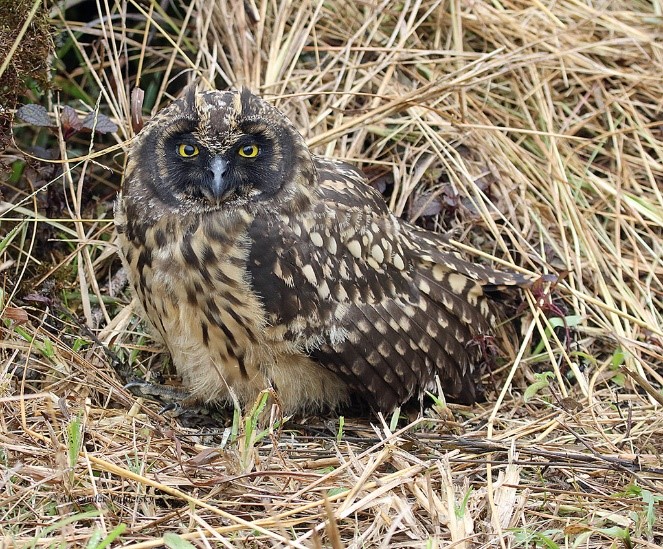
Galápagos Short-eared Owl, juvenile with extensive black shadows around its eyes, and showing its short “ear” tufts. (Los Gemelos, Isla Santa Cruz, Ecuador; June 26, 2017.) © Alexander Viduetsky
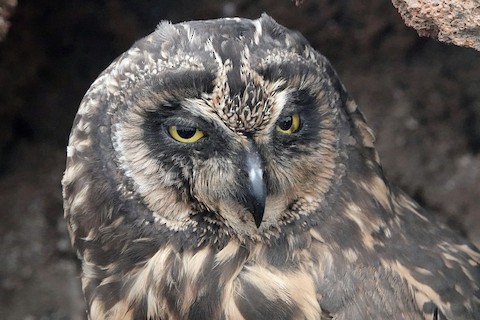
Galápagos Short-eared Owl, adult facial close-up. (Prince Philip’s Steps, Isla Genovesa, Galápagos, Ecuador; July 27, 2022.) © Doug Wassmer
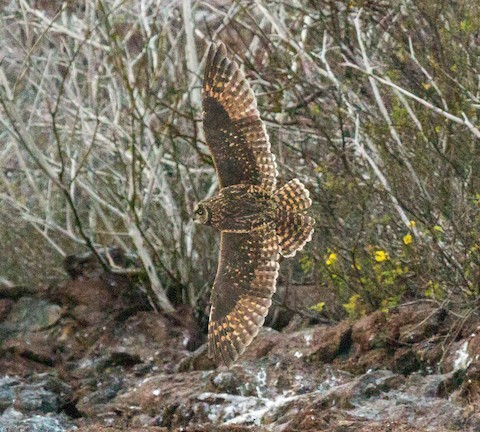
Galápagos Short-eared Owl in flight, dorsal view. (Prince Philip’s Steps, Isla Genovesa, Galápagos, Ecuador; November 30, 2013.) © John Hannan

Galápagos Short-eared Owl in flight, ventral view. (Prince Philip’s Steps, Isla Genovesa, Galápagos, Ecuador; October 12, 2019.) © Ian Routley
Notes
Monotypic species. Traditionally classified as a subspecies of the Short-eared Owl (Asio flammeus), and currently treated as such by formal taxonomic authorities.
Provisionally treated as a separate species here because both recent guidebooks to the owls of the world, König and Weick (2008) and Mikkola (2017), recognize it as such. Their principal bases for distinguishing galapagoensis from flammeus are its apparent genetic isolation and differences in voice, plumage, wing-length, and ecology—among these factors, voice appears to be the most persuasive in light of its importance to owls in general. This is a close judgment call that could go either way.
More Images of the Galápagos Short-eared Owl
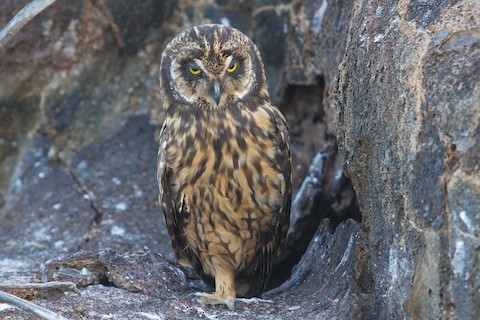
Galápagos Short-eared Owl. (Prince Philip’s Steps, Isla Genovesa, Galápagos, Ecuador; January 10, 2015.) © Brad Dawson
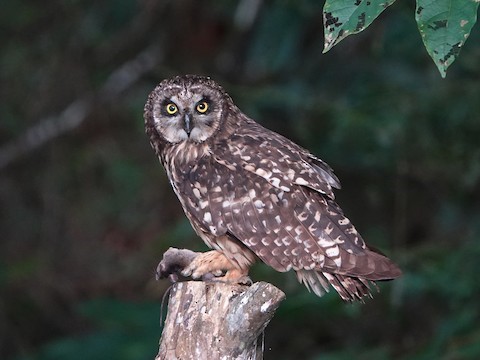
Galápagos Short-eared Owl—with pale spots that are whiter, less buffy, than most. (Santo Tomás, Isla Isabela, Galápagos, Ecuador; May 27, 2022.) © Barry Reed

Galápagos Short-eared Owl, showing its short “ear” tufts. (Sierra Negra, Isla Isabela, Galápagos, Ecuador; January 4, 2019.) © John G. Philips
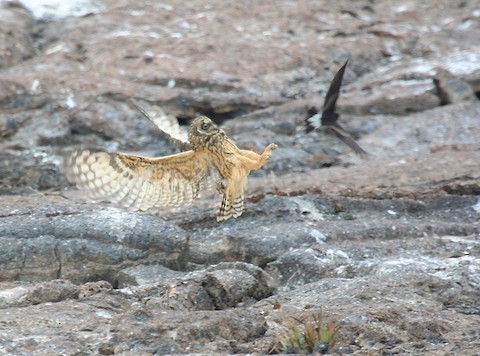
Galápagos Short-eared Owl attempting to capture a Wedge-rumped Storm-Petrel. (Prince Philip’s Steps, Isla Genovesa, Galápagos, Ecuador; July 27, 2007.) © Gil Ewing
References
BirdLife International. 2021. Asio flammeus. The IUCN Red List of Threatened Species 2021: e.T22689531A202226582. https://dx.doi.org/10.2305/IUCN.UK.2021-3.RLTS.T22689531A202226582.en. (Accessed January 18, 2023.)
eBird. 2023. eBird: An online database of bird distribution and abundance. Cornell Lab of Ornithology, Ithaca, N.Y. http://www.ebird.org. (Accessed January 18, 2023.)
iNaturalist. 2023. https://www.inaturalist.org/. (Accessed January 18, 2023.)
König, C., and F. Weick. 2008. Owls of the World (Second Edition). Yale University Press.
Mikkola, H. 2017. Owls of the World: A Photographic Guide: Second Edition. Firefly Books, London.
Xeno-Canto. 2023. Short-eared Owl – Asio flammeus. https://xeno-canto.org/species/Asio-flammeus. (Accessed January 18, 2023.)
